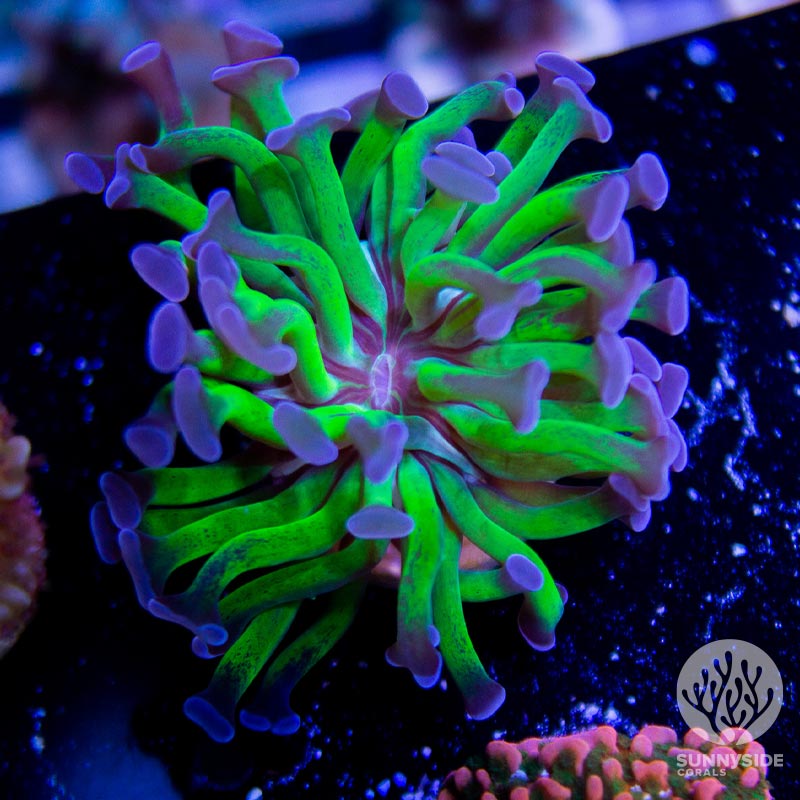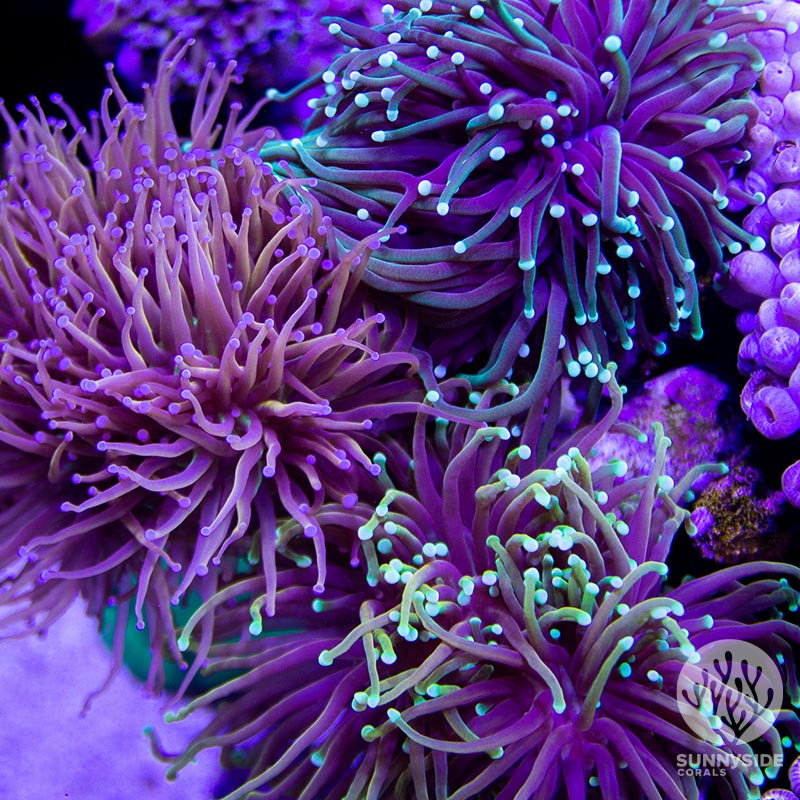Brown jelly euphyllia is a common problem that many reef tank hobbyists face. It is a contagious disease that infects Euphyllia corals, such as hammer and frogspawn corals, causing tissue to turn into a brown jelly-like substance. The exact cause of this disease is still unknown, but it is often associated with the presence of ciliates in large numbers.
Despite the lack of knowledge about the cause of brown jelly euphyllia, there are several treatments that hobbyists have been successful with. These treatments include siphoning the brown jelly and dipping the infected coral. In severe cases, the best solution is to discard the infected coral. There are also in-tank antibiotic treatments that have been experimented with, with some success.
If left untreated, brown jelly euphyllia can quickly spread and infect other corals in the tank. Therefore, it is important for reef tank hobbyists to be aware of the signs and symptoms of this disease and take immediate action to prevent its spread. In this article, we will explore the causes, symptoms, and treatments for brown jelly euphyllia to help hobbyists better understand and manage this common issue in their reef tanks.
What is Brown Jelly?
Brown Jelly is a contagious disease that commonly affects Euphyllia corals. It is named after the brownish, jelly-like substance that forms on the coral’s tissue. The cause of this disease is still unknown, but it is believed to be caused by a bacterial or protozoan infection. The disease usually starts as a small spot on the coral’s tissue and then spreads rapidly, covering the entire coral. Brown Jelly Euphyllia can cause the coral to lose its color, become slimy, and eventually die. It is important to note that Brown Jelly Euphyllia is highly contagious and can spread quickly to other corals in the tank. Therefore, it is crucial to isolate and treat the infected coral as soon as possible to prevent the disease from spreading. Some common symptoms of Brown Jelly Euphyllia include the coral’s tentacles being retracted, the coral’s tissue turning brown and slimy, and the coral losing its color. If you notice any of these symptoms, it is important to take immediate action to prevent further damage to your coral and other corals in your tank.


Causes of Brown Jelly with Euphyllia
Bacterial Infections
Brown jelly disease in Euphyllia corals is believed to be caused by bacterial infections. The exact bacteria responsible for the disease is still unknown, but studies have shown that Vibrio species and Arcobacter species may be involved. These bacteria can enter the coral through small wounds or damaged tissue, and can quickly spread throughout the colony.
Once inside the coral, the bacteria begin to break down the coral’s tissue, resulting in the formation of the brown jelly-like substance that gives the disease its name. The bacteria can also cause the coral to become weakened and more susceptible to other infections and diseases.
Environmental Factors
Environmental factors can also play a role in the development of brown jelly disease in Euphyllia corals. Poor water quality, including high levels of nitrates and phosphates, can weaken the coral and make it more susceptible to infections. High water temperatures can also stress the coral and make it more vulnerable to disease.
Additionally, overcrowding in the aquarium can lead to increased stress and competition among corals, which can make them more susceptible to infections. It is important to maintain proper water quality and provide adequate space for each coral to thrive.
In conclusion, brown jelly disease in Euphyllia corals is caused by bacterial infections and can be exacerbated by poor water quality and overcrowding in the aquarium. Hobbyists should take measures to maintain optimal water quality and provide adequate space for their corals to prevent the development of this disease.
Symptoms of Brown Jelly Euphyllia
Visual Cues
Brown jelly disease is characterized by the presence of a brown, slimy substance on the coral tissue. The brown jelly can appear as a thin film or a thick, gooey layer. This substance is actually a bacterial infection that causes tissue necrosis, or death. As the disease progresses, the brown jelly can spread rapidly to other coral colonies, making it a serious threat to reef ecosystems.
Behavioral Changes
Infected euphyllia colonies may exhibit a range of behavioral changes. For example, they may retract their tentacles or stop extending them altogether. The coral may also appear to be shrinking or receding, which is a sign of tissue loss. In some cases, the coral may completely disintegrate, leaving behind only the skeleton. It’s important to note that brown jelly disease is not always visible to the naked eye. In some cases, the bacteria may be present in the coral tissue without any visible signs of infection. For this reason, it’s important to monitor coral colonies regularly for any changes in behavior or appearance. If left untreated, brown jelly disease can quickly spread throughout a coral colony and to neighboring colonies. It can also weaken the coral’s immune system, making it more susceptible to other infections and diseases. To prevent the spread of brown jelly disease, it’s important to quarantine new coral arrivals and to maintain good water quality in the aquarium. Regular water changes, proper filtration, and adequate flow can all help to prevent the growth of harmful bacteria and maintain a healthy reef environment.
Preventing Brown Jelly Euphyllia
Tank Maintenance
To prevent brown jelly euphyllia, it is important to maintain a healthy and clean tank environment. Regular water changes, proper filtration, and adequate lighting can help keep corals healthy and reduce the risk of disease. It is also important to monitor water parameters such as temperature, salinity, and pH, as fluctuations can stress corals and make them more susceptible to disease. In addition to general tank maintenance, it is important to pay attention to the placement of euphyllia corals in the tank. Euphyllia corals should be placed in areas with moderate water flow and adequate lighting. High flow can damage the delicate tissue of the coral, while low flow can lead to the buildup of detritus and other debris, which can contribute to the growth of harmful bacteria.
Quarantine Procedures
Another important step in preventing brown jelly euphyllia is to quarantine new corals before introducing them to the main tank. This can help prevent the introduction of new pathogens and parasites that can harm existing corals. During the quarantine period, it is important to monitor the health of the new coral and treat any signs of disease before introducing it to the main tank. When selecting new corals, it is also important to choose healthy specimens from reputable sources. Sick or stressed corals are more likely to develop brown jelly and other diseases, so it is important to choose specimens that are free from signs of disease or stress. By following these simple steps, aquarists can help prevent brown jelly euphyllia and keep their coral reefs healthy and thriving.
Treating Brown Jelly Euphyllia
Natural Remedies
When it comes to treating brown jelly euphyllia, there are a few natural remedies that can be effective. One option is to physically remove the brown jelly with a pipette or turkey baster around the infected areas. This must be done carefully to avoid smothering other corals. We suggest turning off all of your flow when doing this in order to minimize the risk fo spread.
Another option is to dip the coral in a solution of iodine or pyodine (10% iodine) and potassium chloride (Kcl). Another natural remedy is to introduce enough bacteria and probiotics to ensure a healthy bacteria colony is present. This can be accomplished by dosing the tank with a product like Microbacter7 or Vibrant. Additionally, ensuring UV is installed can help keep the tank clean and prevent the spread of disease.
Medications
If natural remedies are not effective, medications may be necessary. One option is to use Chemiclean, which is a form of erythromycin. Another option is E.M. Erythromycin (API), which can be effective against brown jelly disease. API Fin and Body Cure (Doxycycline hyclate) is another medication that can be used to treat brown jelly euphyllia. It is important to note that medications should be used with caution and only as a last resort. Overuse of medications can harm the coral and the overall health of the tank. It is also important to follow the instructions carefully and monitor the coral closely during treatment.
Conclusion
Brown jelly disease is a contagious infection that affects Euphyllia corals. The cause of the infection is still unknown, but it is believed to be caused by bacterial or ciliate pathogens. The disease can be identified by the presence of brown, slimy material on the coral’s tissue, which can eventually lead to the coral’s death if left untreated.
There are several treatments that hobbyists have been successful with, including siphoning the brown jelly and dipping the infected coral in a solution of iodine or antibiotics. However, it is important to note that these treatments are not guaranteed to work and can potentially harm the coral if not done correctly.
Preventing brown jelly disease from occurring in the first place is the best course of action. Maintaining proper water quality, avoiding overcrowding in the aquarium, and providing adequate lighting and flow can all help to prevent the spread of the disease. Additionally, quarantining new corals before introducing them to the main tank can help to prevent the spread of infection.
